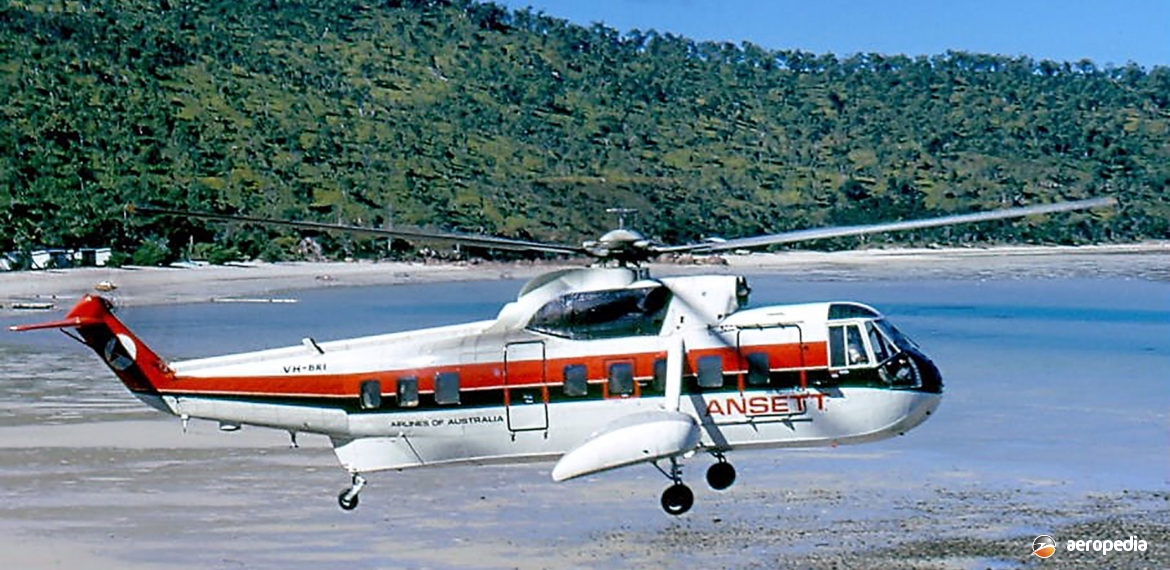Photograph:
Sikorsky S-61 VH-BRI (c/n 61242) landing at Hayman Island, QLD in July 1973 (David C Eyre)
Country of origin:
United States of America
Description:
Commercial transport helicopter
Power Plant:
(S-61N)
Two 1,119 kw (1,500 shp) General Electric CT58-140-2 turboshafts
Specifications:
- Rotor diameter: 18.90 m (62 ft 0 in)
- Fuselage length: 17.96 m (58 ft 11 in)
- Height: 5.63 m (18 ft 5½ in)
- Tail rotor diameter: 3.23 m (10 ft 7 in)
- Main rotor disc area: 280.6 m² (3,020 sq ft)
- Max speed at sea level: 235 km/h (146 mph)
- Typical cruising speed: 222 km/h (138 mph)
- Max inclined rate of climb: 396 m/min (1,300 ft/min)
- Hovering ceiling out of ground effect: 1,158 m (3,800 ft)
- Max range: 833 km (518 miles)
- Empty weight: 5,595 kg (12,336 lb)
- Loaded weight: 8,620 kg (19,000 lb)
History:
The Sikorsky S-61 series was originally designed to meet a US Navy requirement for a single helicopter to perform both the hunter and killer anti-submarine role. Versions were developed for various roles, leading to the design of a machine with a watertight hull and outrigger floats for stability on water, with the main wheels of the undercarriage retracting into the floats. In 1957 Sikorsky decided that the greater power and lighter weight of turbine engines should be combined on an improved design to meet the Navy requirement. These were: an endurance of four hours; accommodation for a crew of four; transportation of full anti-submarine warfare equipment; 381 kg (840 lb) of weapons; and the ability to be operated at night and in bad weather. From this the SH-3A was designed and built. It entered service with the US Navy in 1961.
Six basic variants were produced: the S-61A for military service carrying cargo and personnel; the S-61B/SH-3A anti-submarine helicopter; the VH-3A for the President’s Flight; the S-61L, a non-amphibious civil helicopter; the S-61N, an amphibious civil machine; and the S-61R, a military cargo carrier. On 7 February 1962 the SH-3A gained the world helicopter speed record at 339 km/h (210.6 mph).
Type certification was obtained in November 1961, and the S-61L entered service with Los Angeles Airways. This model accommodated a crew of three and 28 passengers. Later the S-61N was released. It was amphibious, had a retractable undercarriage, and had water sealing. Also, it eliminated the slide-out baggage-pod under the forward fuselage of the S-61L, and reduced the payload to 27 passengers. The first S-61N was flown on 7 September 1962. Production of the S-61 series concluded in 1980, with some 1,100 civil and military aircraft built during the nineteen years in which the type was produced.
A number of S-61Ns have operated in this region. Two were operated by Ansett Airlines on the Proserpine – Mackay – Hayman Island, Lindeman Island, Daydream Island, QLD etc routes. The first VH-BRI² (c/n 61242 – ex BuA48373) was registered on 10 September 1964, and the second VH-BRH (c/n 61748 – ex N4041S) on 24 June 1976. After withdrawal from service, these two aircraft were flown to Melbourne, VIC for sale. It was thought they were to be exported to Grecoair in El Paso, Texas, and were allocated registrations N17AZ and M16AZ. For some reason registrations N-AZ17 and N-AZ16 were painted on the aircraft. In the event they went to Western Australia where they entered service with Barrack Helicopters, a division of Barrack Aviation Services. VH-BRI became VH-BHO, and VH-BRH became VH-BHJ. They were to operate a service from Fremantle to Rottnest Island, in addition to charter work. They only remained for a short period and were shortly thereafter exported.
Others imported to operate on oil rig work over the years have included VH-IMQ (c/n 61671 – ex N611EH), VH-IMS (c/n 61815 – ex N42285), and VH-BHY² (c/n 61470 – ex G-BDRH, 9M-ARV, VR-BDN, N6969R) also flown in Western Australia with Mayne-Bristow Helicopters. These machines were later exported to Canada and were replaced by newer equipment Another example imported VH-UHK² (c/n 61164 – ex N94569) was first registered in February 1970 but was damaged by Cyclone Tracey in the Northern Territory on 24 December 1974.
Examples have been operated in New Zealand. Helicopters (NZ) Ltd leased one (C-FDWC) from Okanagan Helicopters on oil rig work from Invercargill to the Great Southern Basin; and for heavy lift work related to the installation of ski-lifts at Turoa on the south side of Mt Ruapehu. In June 1978 it was flown to Australia via Norfolk Island, making the first crossing from east to west of the Tasman by a large helicopter.
Another S-61 C-GOKH in 1983 was used to service the PENROD semi-submersible drilling rig which was in the Great Southern Basin 161 km (100 miles) south of Invercargill. In 1999 a Sikorsky S-61R N650DC (c/n 61558) was imported and entered service with Helipro from Palmerston North on logging operations. However, it was seriously damaged in an accident not long thereafter and was never placed on the New Zealand register. It survives in storage at Palmerston North.
In 2003 two S-61s, converted for firebombing, arrived in Sydney, NSW. Owned by Carson Helicopters, one was based in the NSW Blue Mountains and the other at Cessnock for the 2003-2004 fire season. Since then further examples have been imported for the fire season each year.
In 2014 C-FIRX (c/n 61-257 – ex N562EH, PH-NZA) arrived in Melbourne, VIC for fire attack duties, being owned by Coulson Aircrane. In recent years further examples have been imported for fire bombing operations, these including Firetrak 347 and 348, operating from Colac, VIC as C-FMAY and C-FIRX.

